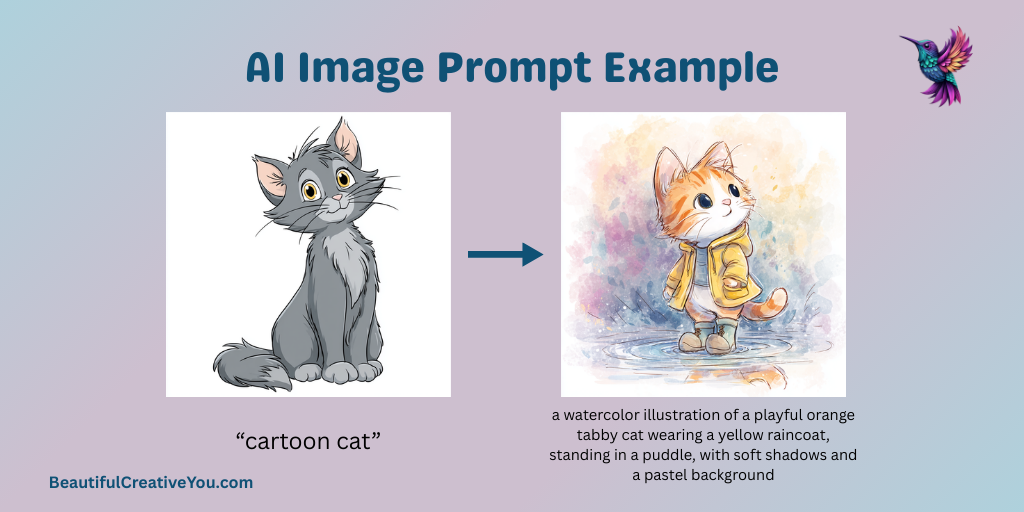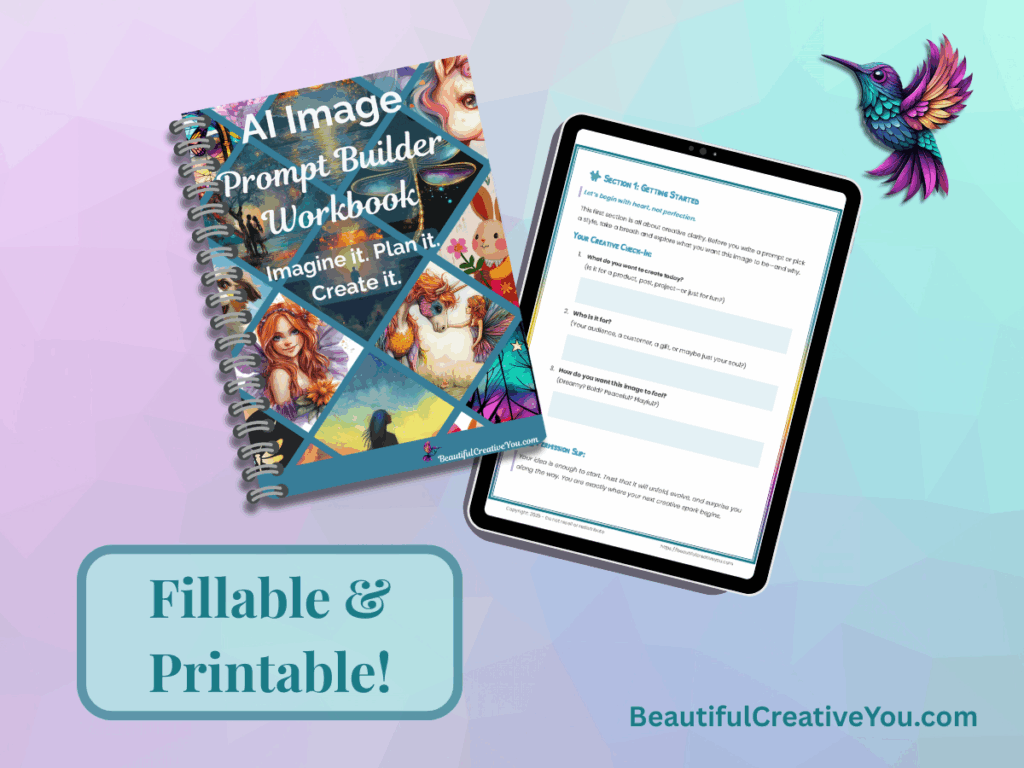Why Clarity Matters When Creating AI Images
You’ve probably heard the word “prompt” tossed around a lot lately—especially if you’ve been anywhere near the world of AI image prompts or tools like ChatGPT. But if you’ve ever paused and thought, “Okay, but what actually ARE AI image prompts”—you’re in good company.
Let me put it this way…
If you’ve ever asked an 8-year-old to “clean your room” and come back to find that they shoved everything under the bed and called it good—you already understand prompting better than you think.
“Clean your room” sounds clear in your mind. You know what you meant. But to that 8-year-old? It could mean anything from stacking toys in the corner to hiding socks in the closet. Now… if you had said, “Put your toys in the basket and make your bed,” the results would’ve probably come out a whole lot closer to what you had in mind.
Prompting an AI works exactly the same way.
The clearer you are about what you want—what you want to see, feel, or get—the more likely the results will actually match the vision in your head.
I once heard someone say, “When you set your goals, you need to be specific. Anything left out will be decided by someone else—and they might not share your vision.” That couldn’t be more true here. If you leave the details to the AI’s imagination, it will fill in the blanks… but you might not like the choices it makes.
That’s why learning how to prompt with purpose matters—whether you’re brand new or you’ve been playing with AI for a while but still feel like your AI image prompts are creating hit-or-miss results.

What Is are AI Image Prompts, Really?
At its simplest, a prompt is just you telling the AI what you want it to do. Nothing more, nothing less.
It’s a set of instructions.
But here’s the catch—AI takes you literally. And unlike your spouse, your kids, or your best friend… it can’t read between the lines or pick up on what you meant if you’re vague or unclear.
Let me give you a quick visual.
If I asked an AI to create “a cartoon cat,” I might get anything from a grumpy tabby to a psychedelic pink cat floating in space.
But if I asked for:
“a watercolor illustration of a playful orange tabby cat wearing a yellow raincoat, standing in a puddle, with soft shadows and a pastel background”
…I’ve given the AI something clear to work with. I’ve painted the picture before asking it to.
That’s the secret to prompting—seeing the result you want first, and describing it as clearly as you can.
The good news?
You don’t have to sound fancy or techie. You just need to practice describing what you already see in your imagination. And the more you practice, the better your results get.
Why Your AI Image Prompts Sometimes Feel a Little… Off
If you’ve ever typed out a prompt and thought, “Well, that’s not what I pictured at all…”, you’re not alone.
In fact, that’s one of the most common frustrations I hear—especially when people are just starting out.
Here are a few reasons your prompts might be missing the mark:
- They’re too vague.
You know what you meant, but the AI doesn’t. If your prompt sounds like a passing thought instead of clear directions, you’ll probably get results that feel random or way off base. - They’re too complicated.
Yep, sometimes trying to sound “AI smart” makes things worse. Long, rambling prompts packed with every idea you have can confuse the AI and lead to weird, jumbled results. - You skipped the vision part.
If you haven’t stopped to picture the end result you actually want—like you’re describing it to a friend—you’re probably leaving too much to chance. - You expected it to just “know.”
Spoiler alert: AI isn’t magic. It’s not going to read your mind or fill in the gaps the way your best friend might. If you leave details out, it will make them up. Sometimes that works. Sometimes… not so much.
The good news is—this is fixable.
Once you learn how to break down your ideas into simple, clear parts, your results start to feel on purpose instead of by accident.
That’s exactly what my AI Image Prompt Builder Workbook is designed to help you do—turn vague ideas into clear, intentional prompts with space to practice and refine your skills as you go.

How to Write Better AI Image Prompts (No Tech Degree Required)
The truth is, you don’t need fancy AI language or secret insider tricks to get better results.
You just need a clear way to organize your thoughts before you hit that “generate” button.
Here’s my go-to simple structure to help you prompt with more purpose and less frustration:
1. What You Want
Start with the main thing you want the AI to create or do.
- Example: “a watercolor illustration of a playful tabby cat”
This is the heart of your prompt—the thing you actually want.
2. How You Want It to Look or Feel
Next, describe the style, mood, or details that bring your idea to life.
- Example: “wearing a yellow raincoat, standing in a puddle, with soft shadows and a pastel background”
Think about colors, emotions, materials, or energy you want it to carry.
3. Any Extras or Specifics
Finally, add any technical or finishing touches like format, layout, or aspect ratio if you need them.
- Example: “centered on a white background, aspect ratio 1:1”
This helps the AI know how to deliver your result.
Let’s See It in Action
Here’s a quick before and after so you can see the difference.
Vague Prompt:
“cartoon cat”
(Result: completely random style, color, and mood)
Clear Prompt Using This Structure:
“a watercolor illustration of a playful orange tabby cat wearing a yellow raincoat, standing in a puddle, with soft shadows and a pastel background, centered on a white background, aspect ratio 1:1”
(Result: way more likely to match your vision)
It’s really that simple.
Start with what, layer in how, and wrap it up with any extras.
The more you practice breaking your ideas down this way, the easier it gets—and the more your results start to actually look and feel the way you pictured them.
Already Know This? Let’s Go Deeper
Now, if you’ve been playing with AI for a while, you might be nodding along thinking, “Yep, I already do that.”
And honestly?
You probably do—at least on the surface.
But here’s what I’ve noticed (and experienced myself):
It’s easy to fall into “prompt autopilot.”
You start recycling the same phrases, relying on old formulas, or tweaking a word here and there—hoping for a better result without really rethinking the heart of your vision.
Sometimes the problem isn’t your wording—it’s that you’ve stopped taking the time to really see the result you want before you start typing.
If that’s you, here’s your challenge:
- Pause before you prompt.
- Picture what you actually want to create—like you’re describing it to someone who can’t read your mind.
- Ask yourself: “If this were the only prompt I could write today, what would I really want it to create for me?”
Because here’s the thing…
Prompting isn’t just about getting something—it’s about creating something you actually care about.
And that’s exactly what my AI Image Prompt Builder Workbook is designed to help you do – turn vague ideas into clear, intentional prompts you actually feel good about. It’s not just a list of tips—it’s a practical space to map out your ideas, practice your wording, and feel more in control of the results you get.
Let’s Put it All Together
You don’t need to sound fancy.
You just need to be clear.
The clearer your vision, the better your prompts—and the more fun this whole creative process becomes.
If you’re ready to take your prompting practice from hit-or-miss to on purpose, I’d love to help you get there.
👉 Click here to join the waitlist and be the first to know when the AI Image Prompt Builder Workbook is ready.
Let’s make your next prompt your best one yet.

